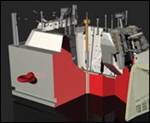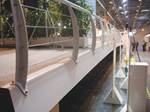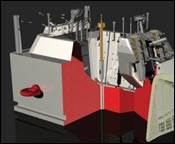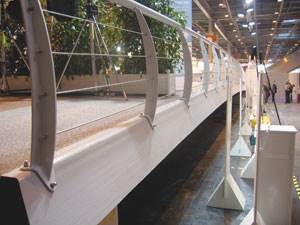Integrated and Automated Knowledge-Based CAM for Better Productivity
A look at a solution for two major problems affecting manufacturing profitability today: (1) the shortage of knowledgeable, experienced engineers and (2) the incompatibilities of CAD/CAM data exchange.
The world manufacturing landscape today finds manufacturers facing several problems that can significantly affect their profit margins.
Shortage of Experienced Manufacturing Engineers
One of these problems is a shortage of knowledgeable experienced manufacturing engineers who can actually generate the code for the CNC machines in the most optimized manner to maximize profitability. This is due to an aging workforce and a lack of experienced engineers. The logical solution is to capture the current knowledge and to automate the output. This is where CAM software with knowledge-based machining can provide a solution. Engineers can identify best processes and lock them in.
Knowledge-Based Machining and Automatic Feature Recognition
Knowledge-based machining (KBM) represents an effort among CAM developers to automate and streamline CNC programming to produce more consistent and accurate programs and to make CNC programmers more productive. Many of these CAM systems are feature-based and provide automatic feature recognition (AFR)—an automated method that analyzes the solid model geometry and identifies regions to be machined.
For example, AFR can define features such as pockets, bosses, holes and slots for milling operations. For turning operations, features such as the OD and ID of the part, front face and grooves can be defined automatically. Semi-automatic methods also are provided for features that are not found by AFR. This combination of automatic and semi-automatic feature definition eliminates the time-consuming process of manually identifying regions to be machined.
Once machinable features have been identified, KBM technology can associate the machining processes, tooling and cutting conditions to the features. Typically, a database stores the machining information. This database can be customized to represent your company’s current machining best practices. For example, you may stock specific tools in your tool crib or you may have an older machine that requires special considerations or you may have a specific way to machine holes. Once you have set up the database for your processes and requirements, it’s locked in and incremental improvements can be made to that baseline.
The net result of feature recognition and KBM is automation that increases productivity and provides a shorter time-to-market. Repetitive programming tasks are automated easing overworked and understaffed CNC programming departments. Tooling and methodology are more consistent and reliable from programmer to programmer and from job to job. Job costs can be substantially reduced.
CAD/CAM Data Exchange
Another problem facing manufacturers is CAD/CAM data exchange. Design data useful for manufacturing is often lost as the solid model data moves from CAD to CAM. Data incompatibility results in more repair work and lost time.
Integrated CAD/CAM
Major solid modelers have partnered with CAM vendors to produce integrated CAD/CAM options.
The interoperability, associativity and data integration provided by these products have resulted in widespread acceptance of this type of integrated CAD/CAM from job shops to large manufacturing companies.
Integrated CAD/CAM has one interface for engineering design and manufacturing. With fully integrated CAM programs, all model data can be used to determine the best machining processes. When working with file formats from other MCAD software, the data can be imported into the solid modeler and any necessary model rework can be done before generating the machining data.
Design changes that could affect production deadlines inevitably take place, which makes good associativity between the CAM data and the solid model critical. When design changes occur, integrated CAM programs have the capability to provide a high level of associativity and can either update machining data automatically or notify users that additional changes are necessary. Time-consuming CAM system rework due to design updates can be avoided or significantly reduced.
The cost of purchasing integrated CAD/CAM software is not generally a problem since some CAM vendors are able to offer their customers a version of the solid modeler at an OEM discount.
Summary
No matter how large your company, you are racing to produce products faster and more accurately while cutting costs and increasing profits. Choosing an automated knowledge-based CAM solution that is fully integrated into a major solid modeler is a best-in-class solution to major issues facing manufacturers today.
Related Content
How to Select a Mold Temperature Controller
White paper shares how cooling channel analysis, which collects maximum pressure drop, total flow rate and heat dissipation, eases the performance evaluation of mold temperature controllers.
Read MoreHow to Fix Predicted Warpage Before It Happens with Windage and CAD Model Morphing
Applying windage and model-morphing techniques saved toolmaker/molder Sturgis Molded Products the time, cost, headaches of multiple part/mold design iteration loops, cumbersome cooling fixtures, and long molding cycles.
Read MoreTolerancing in Mold Design, Part 2: Using GD&T to Address Conventional Tolerancing Issues
Mold designers can achieve a single interpretation of workpiece functionality when following the American Society of Mechanical Engineers Geometric Dimensioning and Tolerancing standard.
Read MoreTolerancing in Mold Design, Part 1: Understanding the Issues of Conventional Bilateral Tolerancing
Mold designers must understand the location, orientation and form limitations of conventional tolerancing before changing to another dimensioning system.
Read MoreRead Next
Single CAD/CAM Software Solution Functions from End-to-End
To streamline design and production processes, one moldmaker decided to use a single CAD/CAM software solution that functions from end-to-end.
Read MoreFive Reasons to Work with Integrated CAD/CAM Software
Nowadays, we hear a lot about integrated CAD/CAM packages and many people wonder whether or not they should buy an integrated package or separate CAD and CAM packages. Here are just some of the reasons why it makes more sense to work with an integrated CAD/CAM package.
Read MoreRediscovering CAM
Exploring underused CAM features that can improve moldmaking productivity and trim operating costs.
Read More




















